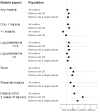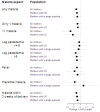Impact of malaria during pregnancy on pregnancy outcomes in a Ugandan prospective cohort with intensive malaria screening and prompt treatment
- PMID: 23617626
- PMCID: PMC3642015
- DOI: 10.1186/1475-2875-12-139
Impact of malaria during pregnancy on pregnancy outcomes in a Ugandan prospective cohort with intensive malaria screening and prompt treatment
Abstract
Background: Malaria in pregnancy (MiP) is a major public health problem in endemic areas of sub-Saharan Africa and has important consequences on birth outcome. Because MiP is a complex phenomenon and malaria epidemiology is rapidly changing, additional evidence is still required to understand how best to control malaria. This study followed a prospective cohort of pregnant women who had access to intensive malaria screening and prompt treatment to identify factors associated with increased risk of MiP and to analyse how various characteristics of MiP affect delivery outcomes.
Methods: Between October 2006 and May 2009, 1,218 pregnant women were enrolled in a prospective cohort. After an initial assessment, they were screened weekly for malaria. At delivery, blood smears were obtained from the mother, placenta, cord and newborn. Multivariate analyses were performed to analyse the association between mothers' characteristics and malaria risk, as well as between MiP and birth outcome, length and weight at birth. This study is a secondary analysis of a trial registered with ClinicalTrials.gov, number NCT00495508.
Results: Overall, 288/1,069 (27%) mothers had 345 peripheral malaria infections. The risk of peripheral malaria was higher in mothers who were younger, infected with HIV, had less education, lived in rural areas or reported no bed net use, whereas the risk of placental infection was associated with more frequent malaria infections and with infection during late pregnancy. The risk of pre-term delivery and of miscarriage was increased in mothers infected with HIV, living in rural areas and with MiP occurring within two weeks of delivery.In adjusted analysis, birth weight but not length was reduced in babies of mothers exposed to MiP (-60 g, 95%CI: -120 to 0 for at least one infection and -150 g, 95%CI: -280 to -20 for >1 infections).
Conclusions: In this study, the timing, parasitaemia level and number of peripherally-detected malaria infections, but not the presence of fever, were associated with adverse birth outcomes. Hence, prompt malaria detection and treatment should be offered to pregnant women regardless of symptoms or other preventive measures used during pregnancy, and with increased focus on mothers living in remote areas.
Figures



References
-
- Steketee RW, Nahlen BL, Parise ME, Menendez C. The burden of malaria in pregnancy in malaria-endemic areas. Am J Trop Med Hyg. 2001;64(1–2 Suppl):28–35. - PubMed
-
- Steketee RW, Wirima JJ, Hightower AW, Slutsker L, Heymann DL, Breman JG. The effect of malaria and malaria prevention in pregnancy on offspring birthweight, prematurity, and intrauterine growth retardation in rural Malawi. Am J Trop Med Hyg. 1996;55(1 Suppl):33–41. - PubMed
Publication types
MeSH terms
Associated data
Grants and funding
LinkOut - more resources
Full Text Sources
Other Literature Sources
Medical

